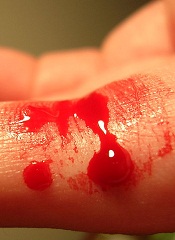
The US Food and Drug Administration (FDA) has approved marketing of an expandable, multi-sponge wound dressing to control bleeding from certain types of wounds inflicted in battle.
The dressing, called XSTAT, is for military use only. It is intended for use on gunshot or shrapnel wounds in areas where a tourniquet cannot be placed, such as the groin or armpit.
The dressing can be used for up to 4 hours, which could allow time for a patient to receive surgical care.
XSTAT consists of 3 syringe-style applicators containing 92 compressed cellulose sponges that have an absorbent coating.
The sponges expand and swell to fill the wound cavity, after approximately 20 seconds upon contact with water from blood or bodily fluid. This creates a temporary physical barrier to blood flow.
The number of sponges needed for effective hemorrhage control will vary depending on the size and depth of the wound. Up to 3 applicators may be used on a patient.
The tablet-shaped sponges are each 9.8 mm in diameter and 4 mm to 5 mm in height. They can absorb 3 mL of blood or body fluid. An applicator filled with 92 sponges, therefore, can absorb about 300 mL of fluid.
The sponges cannot be absorbed by the body, and all sponges must be removed before a wound is closed. For ease of visualization and to confirm removal of every sponge, each sponge contains a marker that is visible via X-ray.
The FDA reviewed XSTAT through its de novo classification process, a regulatory pathway for some novel, low-to-moderate-risk medical devices that are the first of their kind.
Before approving XSTAT, the FDA reviewed data from animal studies demonstrating the product’s ability to stop bleeding and its absorption capacity. The agency also reviewed non-clinical biocompatibility data and results of human factors testing.
XSTAT is manufactured by RevMedX, Inc., in Wilsonville, Oregon. For more information on XSTAT, see the company’s website.

